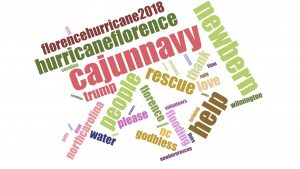As Hurricane Florence approached, CCEE Department Head Dr. Morton Barlaz issued a call for proposals for rapid response research. Three teams were awarded departmental funds to deploy into the field as soon as conditions were safe. “We knew that this was a unique and very time sensitive opportunity to gather data that relate to building resilient infrastructure, and advancing knowledge about storm preparedness,” Barlaz said.
 During hurricanes and other natural disasters, information about flooding hazards, rescue operations, evacuation routes, shelter, and supplies is critical. Through social media platforms, the public can rapidly contribute to and access information as impacts are unfolding. In Hurricane Florence, people sought and received water rescue using Twitter, an online platform called Crowdsource Rescue, and Facebook. The diffusion of disaster information through social media platforms is an important source of aid for victims, and an understanding of how information is conveyed and received via smart technologies can be vital in planning rescue operations, evacuation strategies, and flood control.
During hurricanes and other natural disasters, information about flooding hazards, rescue operations, evacuation routes, shelter, and supplies is critical. Through social media platforms, the public can rapidly contribute to and access information as impacts are unfolding. In Hurricane Florence, people sought and received water rescue using Twitter, an online platform called Crowdsource Rescue, and Facebook. The diffusion of disaster information through social media platforms is an important source of aid for victims, and an understanding of how information is conveyed and received via smart technologies can be vital in planning rescue operations, evacuation strategies, and flood control.
 Dr. Emily Berglund and Morgan DiCarlo began collecting information before Florence made landfall – observing how people were interacting on Facebook’s live hurricane crisis map, following Twitter hashtags such as #florence, #cajunnavy, and #rescue and saving important screenshots. They downloaded Zello, a walkie-talkie like app, subscribed to a “Hurricane Florence!” channel and listened in real time to broadcasts from people seeking water rescue. “So many people contribute to social media sites and can delete their posts at any time. I had to act in the moment to monitor the way information was being diffused over various platforms,” DiCarlo said. “When we briefly lost power the night before landfall, I sat out in my parking lot, charging up my phone in the car so I could stay in the loop during the storm.”
Dr. Emily Berglund and Morgan DiCarlo began collecting information before Florence made landfall – observing how people were interacting on Facebook’s live hurricane crisis map, following Twitter hashtags such as #florence, #cajunnavy, and #rescue and saving important screenshots. They downloaded Zello, a walkie-talkie like app, subscribed to a “Hurricane Florence!” channel and listened in real time to broadcasts from people seeking water rescue. “So many people contribute to social media sites and can delete their posts at any time. I had to act in the moment to monitor the way information was being diffused over various platforms,” DiCarlo said. “When we briefly lost power the night before landfall, I sat out in my parking lot, charging up my phone in the car so I could stay in the loop during the storm.”
“I was a freshman on Long Island during Superstorm Sandy, and I responded as an emergency ambulance volunteer in its aftermath. I saw firsthand that information channels become muddled during a disaster and how devastating the impacts of a storm can be. Since then, while studying civil engineering, I have always thought about how the infrastructure systems we design for people – roadways, traffic flow, electrical grids and water distribution – could be more resilient in a crisis.”
– Morgan DiCarlo
The insights Berglund and DiCarlo are gaining from this research will be used to help communities across North Carolina be prepared for the next major storm which could come at anytime.
See the full story here.